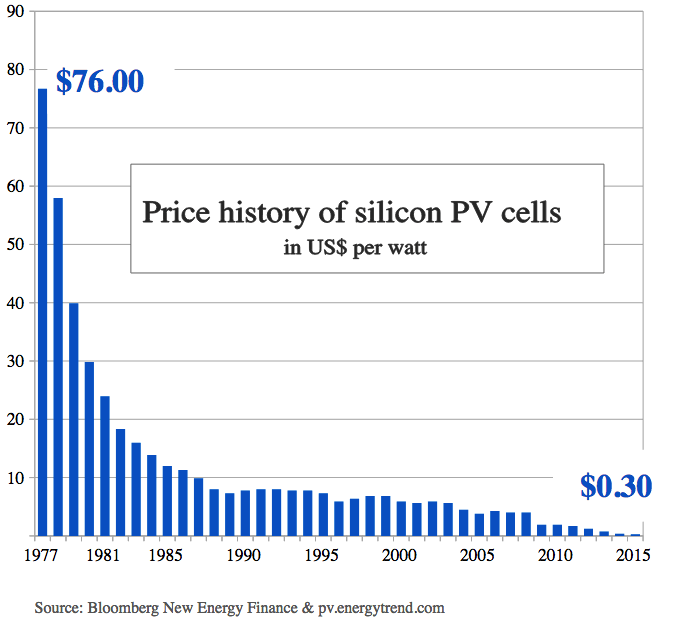A QUICK OVERVIEW of SWANSON'S LAW with GRAPHIC
Here is a graphic that demonstrates the precipitous drop in solar prices the world has experienced from 1977 - 2015:
Here is a graphic that demonstrates the precipitous drop in solar prices the world has experienced from 1977 - 2015:
What Does This Graphic of Solar Prices Show Us?
What you are seeing here is a illustration of what is known as "Swanson's Law" (a relative to "Moore's Law").
"Swanson's Law" is named after Richard Swanson, the founder SunPower, an American solar manufacturer. It is a set of consistent observations around the price of solar panels.
Essentially, when the global manufacturing capacity for solar panels doubles, the average price of producing those panels drops by about 20%. Just about every time. This leads to periods of exponential change where the cost of solar can plummet.
These cost decreases do not happen all of the time. They are dependent on the number of facilities producing solar pv panels and the efficiency with which they are shipped and distributed.
If the global manufacturing capacity of the world stays the same (or decreases), the average price of solar may stay somewhat constant (or increase).
"Swanson's Law" is named after Richard Swanson, the founder SunPower, an American solar manufacturer. It is a set of consistent observations around the price of solar panels.
Essentially, when the global manufacturing capacity for solar panels doubles, the average price of producing those panels drops by about 20%. Just about every time. This leads to periods of exponential change where the cost of solar can plummet.
These cost decreases do not happen all of the time. They are dependent on the number of facilities producing solar pv panels and the efficiency with which they are shipped and distributed.
If the global manufacturing capacity of the world stays the same (or decreases), the average price of solar may stay somewhat constant (or increase).
An Example of Price Stability
As you can see from the graph, between 1990 and 1995, the price of solar was somewhat constant.
This is because the number of facilities producing solar panels was also constant. We can assume that the global demand for solar had stabilized at the conclusion of the 1980s.
However, at the time, solar energy incentives were just getting started. The popularity of solar energy was also expanding incrementally into public awareness. This led to brief periods of increased demand.
By the 2000s, the popularity of solar had allowed the development of additional manufacturing centers.
This allowed prices to begin to edge downward on the whole.
This is because the number of facilities producing solar panels was also constant. We can assume that the global demand for solar had stabilized at the conclusion of the 1980s.
However, at the time, solar energy incentives were just getting started. The popularity of solar energy was also expanding incrementally into public awareness. This led to brief periods of increased demand.
By the 2000s, the popularity of solar had allowed the development of additional manufacturing centers.
This allowed prices to begin to edge downward on the whole.
An Example of Significant Price Decline
Recently however, we've seen a massive increase in global manufacturing capacity!
States around the US have begun to adopt progressive solar policies and countries throughout Europe and the world have heavily subsidized the industry. This has created a strong increase in demand for solar pv panels.
It has also created an astonishing period of solar price reduction and prompted states like Oregon to drop solar energy incentives (this is good news, however).
States around the US have begun to adopt progressive solar policies and countries throughout Europe and the world have heavily subsidized the industry. This has created a strong increase in demand for solar pv panels.
It has also created an astonishing period of solar price reduction and prompted states like Oregon to drop solar energy incentives (this is good news, however).
How Cheap Will Solar Really Get?
We can’t know exactly how cheap solar pv panels will get.
The final average price point will depend on the global solar manufacturing capacity of the world! And some factors are difficult to predict (like the cost of water, cost of mining raw materials and average global economic health, as examples).
Regardless, there will be a limit to the number of times that the total manufacturing capacity of the planet can double (obviously).
In the same way, there will be a limit to just how cheap solar panels can get.
In addition, Swanson’s law predicts price point drops of 20% each time. Therefore, the amount by which prices decrease must level off a bit more each time they decrease.
Read More on this Topic: How Solar Prices Are Beating Out Coal Power.
The final average price point will depend on the global solar manufacturing capacity of the world! And some factors are difficult to predict (like the cost of water, cost of mining raw materials and average global economic health, as examples).
Regardless, there will be a limit to the number of times that the total manufacturing capacity of the planet can double (obviously).
In the same way, there will be a limit to just how cheap solar panels can get.
In addition, Swanson’s law predicts price point drops of 20% each time. Therefore, the amount by which prices decrease must level off a bit more each time they decrease.
Read More on this Topic: How Solar Prices Are Beating Out Coal Power.




